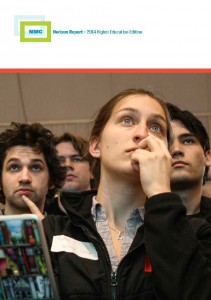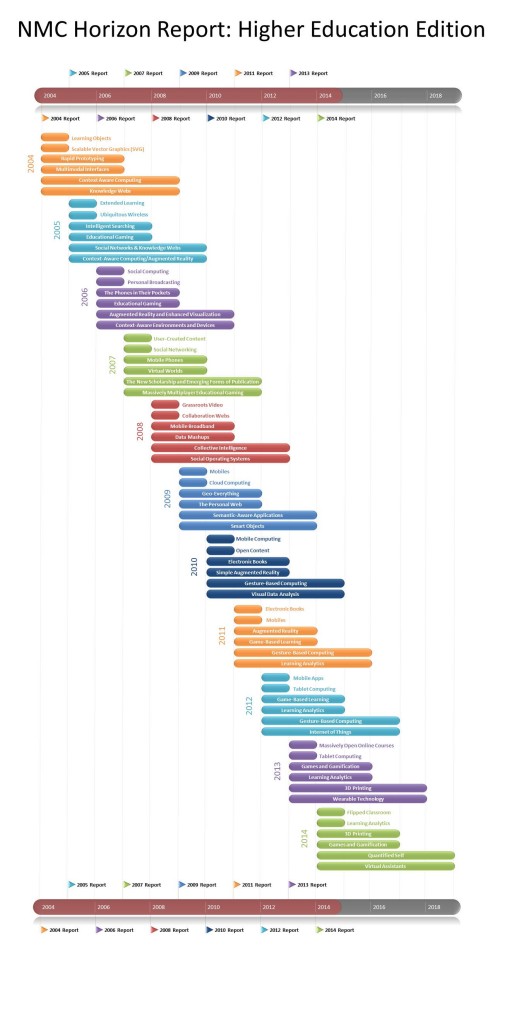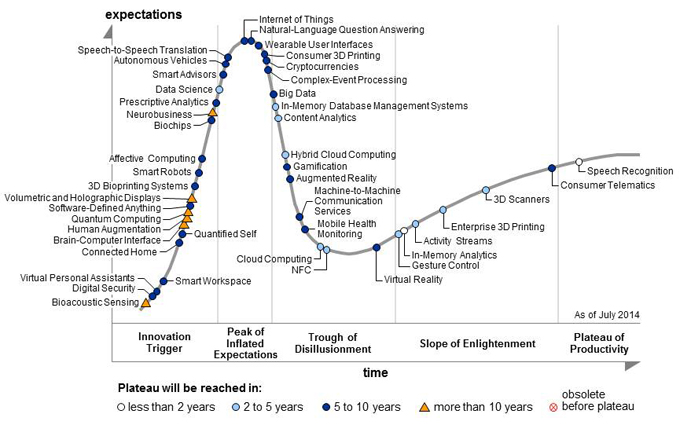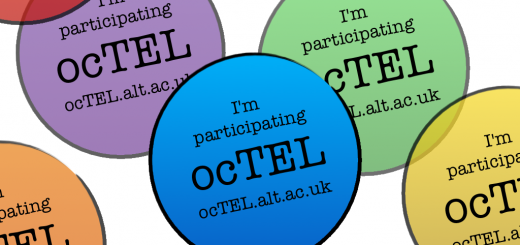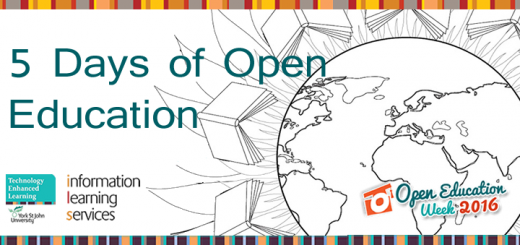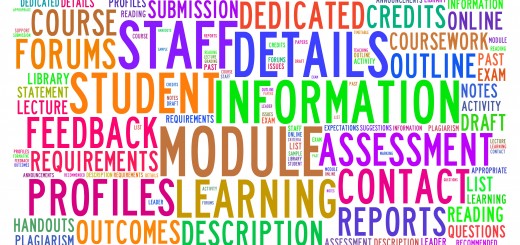Back to the Future II
In my previous ‘Back to the Future‘ post I looked back at the OU Innovating Pedagogy Reports from the last 3 years, this time I’ll be looking at the NMC Horizon Report, which now stretches back over 10 years! While the OU report focuses on pedagogy, and the NMC report on technology, neither report is mutually exclusive, just like technology & pedagogy!
The internationally recognised NMC Horizon Report series are part of the NMC Horizon Project, a comprehensive research venture established in 2002 that identifies and describes emerging technologies likely to have a large impact over the coming five years in education around the globe. The latest volume, the NMC Horizon Report: 2014 Higher Education Edition, examines emerging technologies for their potential impact on and use in teaching, learning, and creative inquiry within the environment of higher education. While it is recognised that there are many local factors affecting the practice of education, there are also issues that transcend geographical boundaries and questions common to higher education; it was with these questions in mind that this report was created. The NMC Horizon Report: 2014 Higher Education Edition is the 11th in the annual higher education series of reports and is produced by the New Media Consortium (NMC) in collaboration with the EDUCAUSE Learning Initiative (ELI).
Important Developments in Educational Technology for Higher Education
Time-to-Adoption: One Year or Less
Flipped Classroom
Learning Analytics
Time-to-Adoption: Two to Three Years
3D Printing
Games and Gamification
Time-to-Adoption: Four to Five Years
Quantified Self
Virtual Assistants
Flipped Classroom
The flipped classroom refers to a model of learning that rearranges how time is spent both in and out of class to shift the ownership of learning from the educators to the students. In the flipped classroom model, valuable class time is devoted to more active, project-based learning where students work together to solve local or global challenges — or other real-world applications — to gain a deeper understanding of the subject. Rather than the teacher using class time to dispense information, that work is done by each student after class, and could take the form of watching video lectures, listening to podcasts, perusing enhanced e-book content, and collaborating with peers in online communities. Students can access this wide variety of resources any time they need them. Teachers can devote more time to interacting with each individual. After class, students manage the content they use, the pace and style of learning, and the ways in which they demonstrate their knowledge; the teacher adapts instructional and collaborative approaches to suit their learning needs and personal learning journeys. The goal is for students to learn more authentically by doing.
Learning Analytics
Learning analytics is an educational application of “big data,” a branch of statistical analysis that was originally developed as a way for businesses to analyze commercial activities, identify spending trends, and predict consumer behavior. As web-tracking tools became more sophisticated, many companies built vast reserves of information to individualize the consumer experience. Education is embarking on a similar pursuit into new ways of applying to improve student engagement and provide a high-quality, personalized experience for learners.
3D Printing
Known in industrial circles as rapid prototyping, 3D printing refers to technologies that construct physical objects from threedimensional (3D) digital content such as 3D modeling software, computer-aided design (CAD) tools, computer-aided tomography (CAT), and X-ray crystallography. A 3D printer builds a tangible model or prototype from the electronic file, one layer at a time, through an extrusion-like process using plastics and other flexible materials, or an inkjet-like process to spray a bonding agent onto a very thin layer of fixable powder. The deposits created by the machine can be applied very accurately to build an object from the bottom up, layer by layer, with resolutions that, even in the least expensive machines, are more than sufficient to express a large amount of detail. The process even accommodates moving parts within the object. Using different materials and bonding agents, color can be applied, and parts can be rendered in plastic, resin, metal, tissue, and even food. This technology is commonly used in manufacturing to build prototypes of almost any object (scaled to fit the printer, of course) that can be conveyed in three dimensions.
Games & Gamification
The games culture has grown to include a substantial proportion of the world’s population, with the age of the average gamer increasing with each passing year. As tablets and smartphones have proliferated, desktop and laptop computers, television sets, and gaming consoles are no longer the only way to connect with other players online, making game-play a portable activity that can happen in a diverse array of settings. Gameplay has long since moved on from solely being recreational and has found considerable traction in the military, business and industry, and increasingly, education as a useful training and motivation tool. While a growing number of educational institutions and programs are experimenting with game-play, there has also been increased attention surrounding gamification — the integration of gaming elements, mechanics, and frameworks into non-game situations and scenarios. Businesses have embraced gamification as a way to design incentive programs that engage employees through rewards, leader boards, and badges, often with a mobile component. Although more nascent than in military or industry settings, the gamification of education is gaining support among educators who recognize that effectively designed games can stimulate large gains in productivity and creativity among learners.
Quantified Self
Quantified self describes the phenomenon of consumers being able to closely track data that is relevant to their daily activities through the use of technology. The emergence of wearable devices on the market such as watches, wristbands, and necklaces that are designed to automatically collect data are helping people manage their fitness, sleep cycles, and eating habits. Mobile apps also share a central role in this idea by providing easyto-read dashboards for consumers to view and analyze their personal metrics. Empowered by these insights, many individuals now rely on these technologies to improve their lifestyle and health. Today’s apps not only track where a person goes, what they do, and how much time they spend doing it, but now what their aspirations are and when those can be accomplished. Novel devices, such as the Memoto, a camera worn around the neck that is designed to capture an image every half minute are enabling people to track their lives automatically. As more people rely on their mobile devices to monitor their daily activities, personal data is becoming a larger part of everyday life.
Virtual Assistants
As voice recognition and gesture-based technologies advance and more recently, converge, we are quickly moving away from the notion of interacting with our devices via a pointer and keyboard. Virtual assistants are a credible extension of work being done with natural user interfaces (NUIs), and the first examples are already in the marketplace. The concept builds on developments in interfaces across the spectrum of engineering, computer science, and biometrics. The Apple iPhone’s Siri and Android’s Jelly Bean are recent mobile-based examples, and allow users to control all the functions of the phone, participate in lifelike conversations with the virtual assistant, and more. A new class of smart televisions are among the first devices to make comprehensive use of the idea. While crude versions of virtual assistants have been around for some time, we have yet to achieve the level of interactivity seen in Apple’s classic video, Knowledge Navigator. Virtual assistants of that caliber and their applications for learning are clearly in the long-term horizon, but the potential of the technology to add substance to informal modes of learning is compelling.
Previous Reports
| NMC Horizon Report: 2013 Higher Education Edition | ||
| One Year or Less | Two to Three Years | Four to Five Years |
| Massively Open Online Courses Tablet Computing |
Games and Gamification Learning Analytics |
3D Printing Wearable Technology |
| NMC Horizon Report: 2012 Higher Education Edition | ||
| One Year or Less | Two to Three Years | Four to Five Years |
| Mobile Apps Tablet Computing |
Game-Based Learning Learning Analytics |
Gesture-Based Computing Internet of Things |
| NMC Horizon Report: 2011 Higher Education Edition | ||
| One Year or Less | Two to Three Years | Four to Five Years |
| Electronic Books Mobiles |
Augmented Reality Game-Based Learning |
Gesture-Based Computing Learning Analytics |
| NMC Horizon Report: 2010 Higher Education Edition | ||
| One Year or Less | Two to Three Years | Four to Five Years |
| Mobile Computing Open Content |
Electronic Books Simple Augmented Reality |
Gesture-Based Computing Visual Data Analysis |
| NMC Horizon Report: 2009 Higher Education Edition | ||
| One Year or Less | Two to Three Years | Four to Five Years |
| Mobiles Cloud Computing |
Geo-Everything The Personal Web |
Semantic-Aware Applications Smart Objects |
| NMC Horizon Report: 2008 Higher Education Edition | ||
| One Year or Less | Two to Three Years | Four to Five Years |
| Grassroots Video Collaboration Webs |
Mobile Broadband Data Mashups |
Collective Intelligence Social Operating Systems |
| NMC Horizon Report: 2007 Higher Education Edition | ||
| One Year or Less | Two to Three Years | Four to Five Years |
| User-Created Content Social Networking |
Mobile Phones Virtual Worlds |
The New Scholarship and Emerging Forms of Publication Massively Multiplayer Educational Gaming |
| NMC Horizon Report: 2006 Higher Education Edition | ||
| One Year or Less | Two to Three Years | Four to Five Years |
| Social Computing Personal Broadcasting |
The Phones in Their Pockets Educational Gaming |
Augmented Reality and Enhanced Visualization Context-Aware Environments and Devices |
| NMC Horizon Report: 2005 Higher Education Edition | ||
| One Year or Less | Two to Three Years | Four to Five Years |
| Extended Learning Ubiquitous Wireless |
Intelligent Searching Educational Gaming |
Social Networks & Knowledge Webs Context-Aware Computing/Augmented Reality |
| NMC Horizon Report: 2004 Higher Education Edition | ||
| One Year or Less | Two to Three Years | Four to Five Years |
| Learning Objects Scalable Vector Graphics (SVG) |
Rapid Prototyping Multimodal Interfaces |
Context Aware Computing Knowledge Webs |
Don’t Believe the Hype?
Where would you put some of these approaches & innovations on the Gartner Hype Cycle? Please contribute your comments on the report and the innovations using the comments section below…
Phil
Reference
Johnson, L., Adams Becker, S., Estrada, V., Freeman, A. (2014). NMC Horizon Report: 2014 Higher Education Edition. Austin, Texas: The New Media Consortium.
